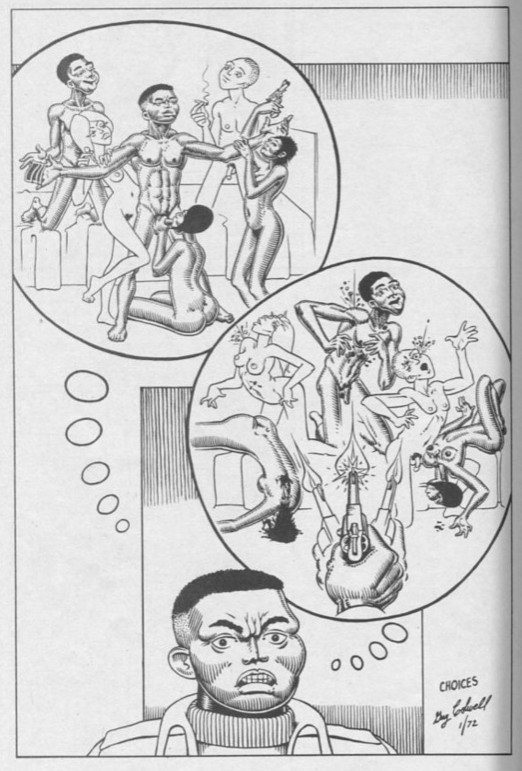"Choices," Inner City Romance Comix 1 (1972)
Dublin Core
Title
Subject
Description
In this first image, James faces a choice: Should he settle into the hedonistic ways of his friend Marvin, or should he violently rebel against those ways and their lack of productivity? The representation of James’ struggle in this first image exemplifies the politics of underground comix and the black liberation struggle of 1970s America. In his essay “Icons of the Alternate Culture,” Clinton Sanders notes that “a common creative premise found in comix is the confrontation between the upstanding, white, middle-class, middle-aged citizen and the cultural or racial deviant” (841). This image subverts that common theme. While Marvin certainly represents the deviant or the “freak,” James can hardly be considered the antagonistic “straight” (Sanders 841). In contrast to Marvin, James certainly plays the role of the straight, fulfilling the “assumption.” Sanders observes that “the exotic hedonistic pleasures of the hip subculture exert a powerful pull on straights” (841). James’ face contorts almost in anguish, as the temptation of pleasure combats his desire for progress. However, his alternative is hardly straight, and nothing about James embodies the figure of “upstanding, white, middle-class, middle-aged citizen.”
Interestingly, while Marvin’s temptation does beckon to James, “Choices” resists the common trope of the deviant’s victory (Sanders 841). If James chooses the violent choice, then Marvin dies with a look of bemused shock on his face, perhaps a nod to the advantage his role usually has in the medium. However if James chooses to surrender to pleasure, sex and drugs, then he still emerges victorious. This victory is evident in the first image where James stands at the center of the orgy in a Christ-like pose as women, black and white, marvel at his manhood and his male friends look on with pleasure, support and respect.
Sanders argues that this type of Christian imagery is another common element of underground comix (845). In this particular image, the parodic invocation of Christ delineates the stark differences between the choices James faces and at the same time critiques both choices. By choosing pleasure, James sacrifices himself as an agent of change, but the crimes that society has inflicted on him absolve him of the sin. And by choosing violence, James agitates toward the difference he wants to make, becoming a militant civil rights crusader, but also undermines the morals that undergird his humanity. Through blasphemous parody, James’s imposition into the Christ pose emphasizes that despite the contrasts between him and Marvin, he was never the “straight.” This idea encapsulates what Sanders describes as a tendency of underground comix to “provide the vacillating straight with a new way to look at reality and a repertoire of alternate behavioral models” (848-9). Whichever way James may choose, his decision and the disgust that fuels it lie within the realm of counter-culture, and through this choice Colwell is able to underscore the place of underground comix and yet at the same time criticize the counter-culture in which they reside.
Sanders, Clinton R. "Icons of the Alternate Culture: The Themes and Functions of Underground Comix*." The Journal of Popular Culture 8.4 (1975): 836-852. doi: 10.1111/j.0022-3840.1975.00836.x
Creator
Source
Publisher
Date
Format
Language
Type
Citation
Catalog Search
Search for related records in these catalogs:
